Comparative Financial Report: Q Powerboat vs. S Powerboat Projects
VerifiedAdded on 2021/06/17
|6
|2104
|19
Report
AI Summary
This report provides a comparative financial analysis of two powerboat projects, Q and S, using capital budgeting techniques to aid in decision-making. The analysis includes calculations for initial, terminal, and operating cash flows for both projects. Quantitative aspects are evaluated using net present value (NPV), internal rate of return (IRR), and discounted payback period. The report calculates and compares these metrics for both projects, considering a 20% discount rate. The analysis reveals that the Q powerboat project has a positive NPV and an IRR significantly higher than the weighted average cost of capital, with a discounted payback period within the acceptable timeframe. However, the S powerboat project exhibits a higher NPV. Qualitative factors, such as environmental impact and revenue trends, are also considered, with the S powerboat project being environmentally friendly and showing increasing revenue. The report concludes with a recommendation to proceed with the S powerboat project due to its superior financial performance and positive qualitative attributes.
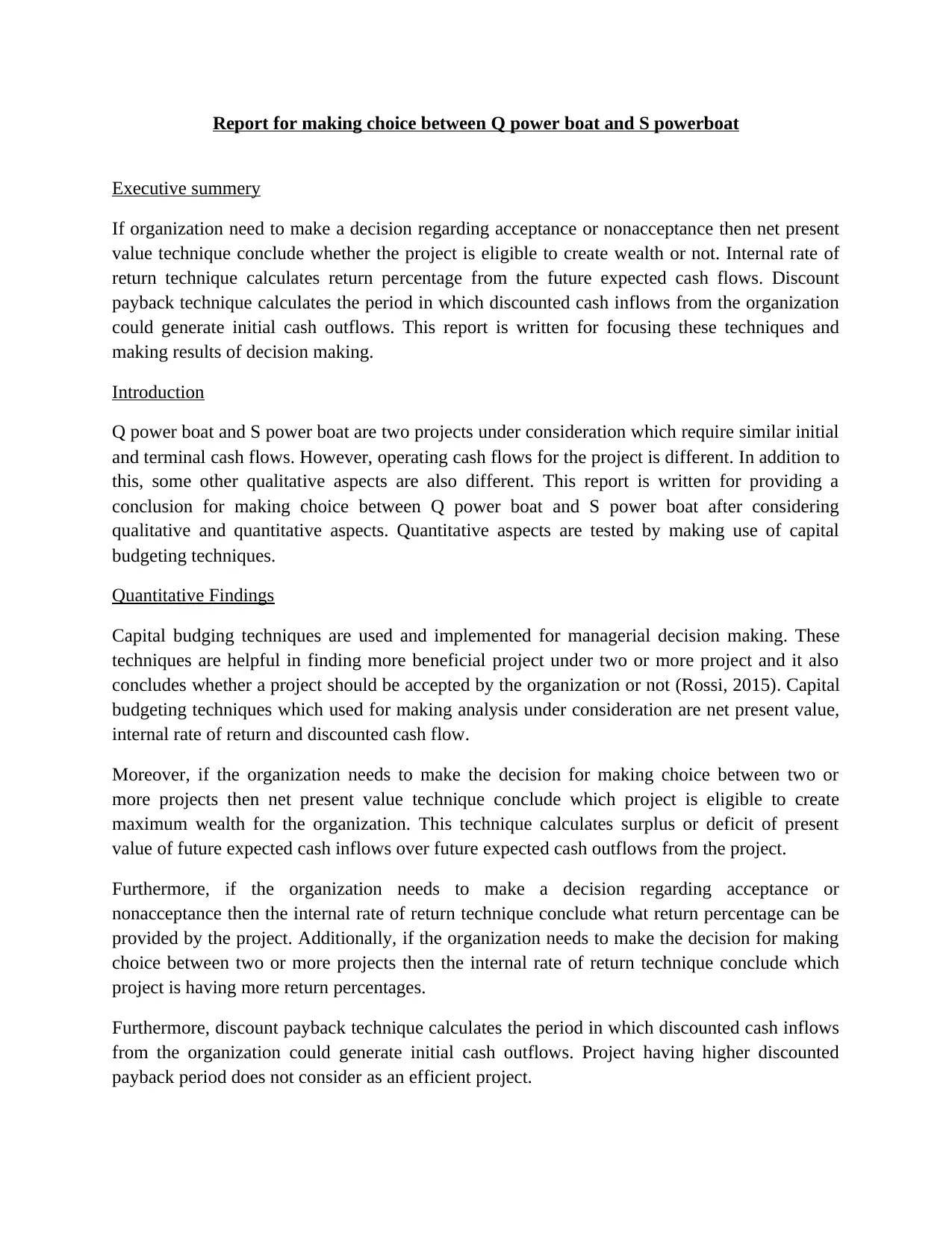
Report for making choice between Q power boat and S powerboat
Executive summery
If organization need to make a decision regarding acceptance or nonacceptance then net present
value technique conclude whether the project is eligible to create wealth or not. Internal rate of
return technique calculates return percentage from the future expected cash flows. Discount
payback technique calculates the period in which discounted cash inflows from the organization
could generate initial cash outflows. This report is written for focusing these techniques and
making results of decision making.
Introduction
Q power boat and S power boat are two projects under consideration which require similar initial
and terminal cash flows. However, operating cash flows for the project is different. In addition to
this, some other qualitative aspects are also different. This report is written for providing a
conclusion for making choice between Q power boat and S power boat after considering
qualitative and quantitative aspects. Quantitative aspects are tested by making use of capital
budgeting techniques.
Quantitative Findings
Capital budging techniques are used and implemented for managerial decision making. These
techniques are helpful in finding more beneficial project under two or more project and it also
concludes whether a project should be accepted by the organization or not (Rossi, 2015). Capital
budgeting techniques which used for making analysis under consideration are net present value,
internal rate of return and discounted cash flow.
Moreover, if the organization needs to make the decision for making choice between two or
more projects then net present value technique conclude which project is eligible to create
maximum wealth for the organization. This technique calculates surplus or deficit of present
value of future expected cash inflows over future expected cash outflows from the project.
Furthermore, if the organization needs to make a decision regarding acceptance or
nonacceptance then the internal rate of return technique conclude what return percentage can be
provided by the project. Additionally, if the organization needs to make the decision for making
choice between two or more projects then the internal rate of return technique conclude which
project is having more return percentages.
Furthermore, discount payback technique calculates the period in which discounted cash inflows
from the organization could generate initial cash outflows. Project having higher discounted
payback period does not consider as an efficient project.
Executive summery
If organization need to make a decision regarding acceptance or nonacceptance then net present
value technique conclude whether the project is eligible to create wealth or not. Internal rate of
return technique calculates return percentage from the future expected cash flows. Discount
payback technique calculates the period in which discounted cash inflows from the organization
could generate initial cash outflows. This report is written for focusing these techniques and
making results of decision making.
Introduction
Q power boat and S power boat are two projects under consideration which require similar initial
and terminal cash flows. However, operating cash flows for the project is different. In addition to
this, some other qualitative aspects are also different. This report is written for providing a
conclusion for making choice between Q power boat and S power boat after considering
qualitative and quantitative aspects. Quantitative aspects are tested by making use of capital
budgeting techniques.
Quantitative Findings
Capital budging techniques are used and implemented for managerial decision making. These
techniques are helpful in finding more beneficial project under two or more project and it also
concludes whether a project should be accepted by the organization or not (Rossi, 2015). Capital
budgeting techniques which used for making analysis under consideration are net present value,
internal rate of return and discounted cash flow.
Moreover, if the organization needs to make the decision for making choice between two or
more projects then net present value technique conclude which project is eligible to create
maximum wealth for the organization. This technique calculates surplus or deficit of present
value of future expected cash inflows over future expected cash outflows from the project.
Furthermore, if the organization needs to make a decision regarding acceptance or
nonacceptance then the internal rate of return technique conclude what return percentage can be
provided by the project. Additionally, if the organization needs to make the decision for making
choice between two or more projects then the internal rate of return technique conclude which
project is having more return percentages.
Furthermore, discount payback technique calculates the period in which discounted cash inflows
from the organization could generate initial cash outflows. Project having higher discounted
payback period does not consider as an efficient project.
Paraphrase This Document
Need a fresh take? Get an instant paraphrase of this document with our AI Paraphraser
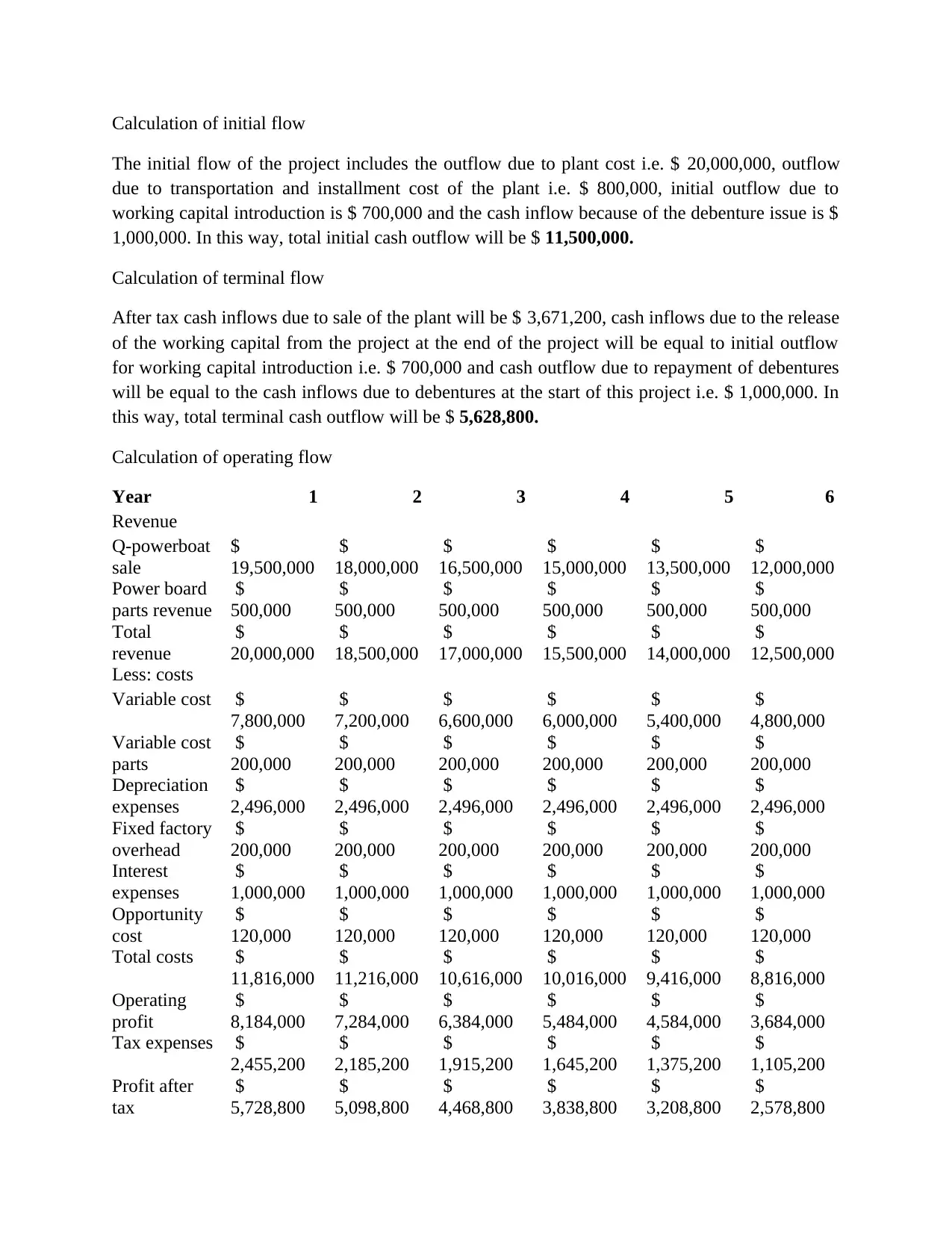
Calculation of initial flow
The initial flow of the project includes the outflow due to plant cost i.e. $ 20,000,000, outflow
due to transportation and installment cost of the plant i.e. $ 800,000, initial outflow due to
working capital introduction is $ 700,000 and the cash inflow because of the debenture issue is $
1,000,000. In this way, total initial cash outflow will be $ 11,500,000.
Calculation of terminal flow
After tax cash inflows due to sale of the plant will be $ 3,671,200, cash inflows due to the release
of the working capital from the project at the end of the project will be equal to initial outflow
for working capital introduction i.e. $ 700,000 and cash outflow due to repayment of debentures
will be equal to the cash inflows due to debentures at the start of this project i.e. $ 1,000,000. In
this way, total terminal cash outflow will be $ 5,628,800.
Calculation of operating flow
Year 1 2 3 4 5 6
Revenue
Q-powerboat
sale
$
19,500,000
$
18,000,000
$
16,500,000
$
15,000,000
$
13,500,000
$
12,000,000
Power board
parts revenue
$
500,000
$
500,000
$
500,000
$
500,000
$
500,000
$
500,000
Total
revenue
$
20,000,000
$
18,500,000
$
17,000,000
$
15,500,000
$
14,000,000
$
12,500,000
Less: costs
Variable cost $
7,800,000
$
7,200,000
$
6,600,000
$
6,000,000
$
5,400,000
$
4,800,000
Variable cost
parts
$
200,000
$
200,000
$
200,000
$
200,000
$
200,000
$
200,000
Depreciation
expenses
$
2,496,000
$
2,496,000
$
2,496,000
$
2,496,000
$
2,496,000
$
2,496,000
Fixed factory
overhead
$
200,000
$
200,000
$
200,000
$
200,000
$
200,000
$
200,000
Interest
expenses
$
1,000,000
$
1,000,000
$
1,000,000
$
1,000,000
$
1,000,000
$
1,000,000
Opportunity
cost
$
120,000
$
120,000
$
120,000
$
120,000
$
120,000
$
120,000
Total costs $
11,816,000
$
11,216,000
$
10,616,000
$
10,016,000
$
9,416,000
$
8,816,000
Operating
profit
$
8,184,000
$
7,284,000
$
6,384,000
$
5,484,000
$
4,584,000
$
3,684,000
Tax expenses $
2,455,200
$
2,185,200
$
1,915,200
$
1,645,200
$
1,375,200
$
1,105,200
Profit after
tax
$
5,728,800
$
5,098,800
$
4,468,800
$
3,838,800
$
3,208,800
$
2,578,800
The initial flow of the project includes the outflow due to plant cost i.e. $ 20,000,000, outflow
due to transportation and installment cost of the plant i.e. $ 800,000, initial outflow due to
working capital introduction is $ 700,000 and the cash inflow because of the debenture issue is $
1,000,000. In this way, total initial cash outflow will be $ 11,500,000.
Calculation of terminal flow
After tax cash inflows due to sale of the plant will be $ 3,671,200, cash inflows due to the release
of the working capital from the project at the end of the project will be equal to initial outflow
for working capital introduction i.e. $ 700,000 and cash outflow due to repayment of debentures
will be equal to the cash inflows due to debentures at the start of this project i.e. $ 1,000,000. In
this way, total terminal cash outflow will be $ 5,628,800.
Calculation of operating flow
Year 1 2 3 4 5 6
Revenue
Q-powerboat
sale
$
19,500,000
$
18,000,000
$
16,500,000
$
15,000,000
$
13,500,000
$
12,000,000
Power board
parts revenue
$
500,000
$
500,000
$
500,000
$
500,000
$
500,000
$
500,000
Total
revenue
$
20,000,000
$
18,500,000
$
17,000,000
$
15,500,000
$
14,000,000
$
12,500,000
Less: costs
Variable cost $
7,800,000
$
7,200,000
$
6,600,000
$
6,000,000
$
5,400,000
$
4,800,000
Variable cost
parts
$
200,000
$
200,000
$
200,000
$
200,000
$
200,000
$
200,000
Depreciation
expenses
$
2,496,000
$
2,496,000
$
2,496,000
$
2,496,000
$
2,496,000
$
2,496,000
Fixed factory
overhead
$
200,000
$
200,000
$
200,000
$
200,000
$
200,000
$
200,000
Interest
expenses
$
1,000,000
$
1,000,000
$
1,000,000
$
1,000,000
$
1,000,000
$
1,000,000
Opportunity
cost
$
120,000
$
120,000
$
120,000
$
120,000
$
120,000
$
120,000
Total costs $
11,816,000
$
11,216,000
$
10,616,000
$
10,016,000
$
9,416,000
$
8,816,000
Operating
profit
$
8,184,000
$
7,284,000
$
6,384,000
$
5,484,000
$
4,584,000
$
3,684,000
Tax expenses $
2,455,200
$
2,185,200
$
1,915,200
$
1,645,200
$
1,375,200
$
1,105,200
Profit after
tax
$
5,728,800
$
5,098,800
$
4,468,800
$
3,838,800
$
3,208,800
$
2,578,800
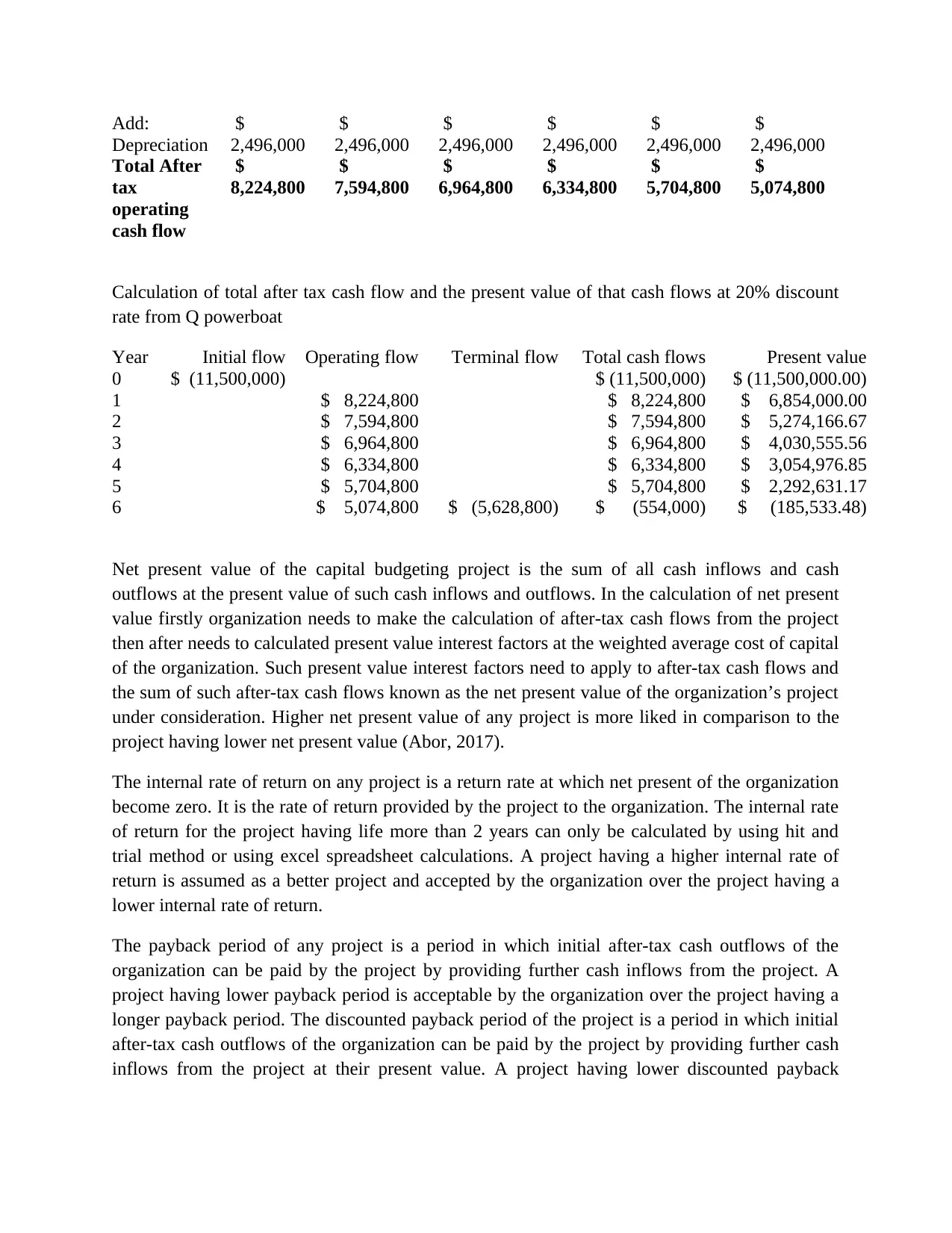
Add:
Depreciation
$
2,496,000
$
2,496,000
$
2,496,000
$
2,496,000
$
2,496,000
$
2,496,000
Total After
tax
operating
cash flow
$
8,224,800
$
7,594,800
$
6,964,800
$
6,334,800
$
5,704,800
$
5,074,800
Calculation of total after tax cash flow and the present value of that cash flows at 20% discount
rate from Q powerboat
Year Initial flow Operating flow Terminal flow Total cash flows Present value
0 $ (11,500,000) $ (11,500,000) $ (11,500,000.00)
1 $ 8,224,800 $ 8,224,800 $ 6,854,000.00
2 $ 7,594,800 $ 7,594,800 $ 5,274,166.67
3 $ 6,964,800 $ 6,964,800 $ 4,030,555.56
4 $ 6,334,800 $ 6,334,800 $ 3,054,976.85
5 $ 5,704,800 $ 5,704,800 $ 2,292,631.17
6 $ 5,074,800 $ (5,628,800) $ (554,000) $ (185,533.48)
Net present value of the capital budgeting project is the sum of all cash inflows and cash
outflows at the present value of such cash inflows and outflows. In the calculation of net present
value firstly organization needs to make the calculation of after-tax cash flows from the project
then after needs to calculated present value interest factors at the weighted average cost of capital
of the organization. Such present value interest factors need to apply to after-tax cash flows and
the sum of such after-tax cash flows known as the net present value of the organization’s project
under consideration. Higher net present value of any project is more liked in comparison to the
project having lower net present value (Abor, 2017).
The internal rate of return on any project is a return rate at which net present of the organization
become zero. It is the rate of return provided by the project to the organization. The internal rate
of return for the project having life more than 2 years can only be calculated by using hit and
trial method or using excel spreadsheet calculations. A project having a higher internal rate of
return is assumed as a better project and accepted by the organization over the project having a
lower internal rate of return.
The payback period of any project is a period in which initial after-tax cash outflows of the
organization can be paid by the project by providing further cash inflows from the project. A
project having lower payback period is acceptable by the organization over the project having a
longer payback period. The discounted payback period of the project is a period in which initial
after-tax cash outflows of the organization can be paid by the project by providing further cash
inflows from the project at their present value. A project having lower discounted payback
Depreciation
$
2,496,000
$
2,496,000
$
2,496,000
$
2,496,000
$
2,496,000
$
2,496,000
Total After
tax
operating
cash flow
$
8,224,800
$
7,594,800
$
6,964,800
$
6,334,800
$
5,704,800
$
5,074,800
Calculation of total after tax cash flow and the present value of that cash flows at 20% discount
rate from Q powerboat
Year Initial flow Operating flow Terminal flow Total cash flows Present value
0 $ (11,500,000) $ (11,500,000) $ (11,500,000.00)
1 $ 8,224,800 $ 8,224,800 $ 6,854,000.00
2 $ 7,594,800 $ 7,594,800 $ 5,274,166.67
3 $ 6,964,800 $ 6,964,800 $ 4,030,555.56
4 $ 6,334,800 $ 6,334,800 $ 3,054,976.85
5 $ 5,704,800 $ 5,704,800 $ 2,292,631.17
6 $ 5,074,800 $ (5,628,800) $ (554,000) $ (185,533.48)
Net present value of the capital budgeting project is the sum of all cash inflows and cash
outflows at the present value of such cash inflows and outflows. In the calculation of net present
value firstly organization needs to make the calculation of after-tax cash flows from the project
then after needs to calculated present value interest factors at the weighted average cost of capital
of the organization. Such present value interest factors need to apply to after-tax cash flows and
the sum of such after-tax cash flows known as the net present value of the organization’s project
under consideration. Higher net present value of any project is more liked in comparison to the
project having lower net present value (Abor, 2017).
The internal rate of return on any project is a return rate at which net present of the organization
become zero. It is the rate of return provided by the project to the organization. The internal rate
of return for the project having life more than 2 years can only be calculated by using hit and
trial method or using excel spreadsheet calculations. A project having a higher internal rate of
return is assumed as a better project and accepted by the organization over the project having a
lower internal rate of return.
The payback period of any project is a period in which initial after-tax cash outflows of the
organization can be paid by the project by providing further cash inflows from the project. A
project having lower payback period is acceptable by the organization over the project having a
longer payback period. The discounted payback period of the project is a period in which initial
after-tax cash outflows of the organization can be paid by the project by providing further cash
inflows from the project at their present value. A project having lower discounted payback
⊘ This is a preview!⊘
Do you want full access?
Subscribe today to unlock all pages.

Trusted by 1+ million students worldwide

period is acceptable by the organization over the project having longer discounted payback
period.
An organization must have a positive net present value for accepting a project otherwise project
is expected to provide loss. Additionally, internal rate of return of the project must be higher than
the cost of capital of the organization so that difference between these two rates can be earned by
the organization as income. Moreover, every organization is having some period after which
organization needs to show profits from the project, discounted payback period of the
organization’s project should be lower than the acceptable period from continuing with the
project.
In the present case net present value of the Q power boat is $ 9,820,796.77. It is a positive net
present value; hence from the perspective of net present value, this project is acceptable.
Additionally, internal rate of return of the project is 58.50%; on the other hand, weighted average
cost of capital of the organization is only 20% to 25%. Hence return rate is given by the project
higher than the weighted average cost of capital of the organization, in this way; hence from the
perspective of internal rate of return, this project is acceptable. Furthermore, the discounted
payback period of the project is 2.14 years; however acceptable discounted payback period of the
organization for every project is 4 years. In this way, a discounted period of the project is lower
than the acceptable discounted payback period. Hence from the perspective of discounted
payback period, this project is acceptable. Hence it can be concluded that all capital budgeting
techniques’ are supporting the acceptance of Q powerboat project.
Qualitative findings
However, Q powerboat is having a qualitative characteristic which makes this project less
effective. This product manufactured from this project is expected to do emission of carbon
partials in water which results in water pollution and degradation. Due to this characteristic, this
project can be demoted by environment protectors. In addition to this, this project is having
declining expected revenue which also shows the effect of bad publicity on the organization’s
productivity. Hence for this perspective, this project becomes unacceptable.
Comparison of Q powerboat with S powerboat
Quantitative findings
Calculation of net present value from operating flows of both project
Year Cash flows from Q power
boat
Present value
Discount rate 20% Discount rate 25%
1 $ 8,224,800.00 $ 6,854,000.00 $ 6,579,840.00
2 $ 7,594,800.00 $ 5,274,166.67 $ 4,860,672.00
3 $ 6,964,800.00 $ 4,030,555.56 $ 3,565,977.60
period.
An organization must have a positive net present value for accepting a project otherwise project
is expected to provide loss. Additionally, internal rate of return of the project must be higher than
the cost of capital of the organization so that difference between these two rates can be earned by
the organization as income. Moreover, every organization is having some period after which
organization needs to show profits from the project, discounted payback period of the
organization’s project should be lower than the acceptable period from continuing with the
project.
In the present case net present value of the Q power boat is $ 9,820,796.77. It is a positive net
present value; hence from the perspective of net present value, this project is acceptable.
Additionally, internal rate of return of the project is 58.50%; on the other hand, weighted average
cost of capital of the organization is only 20% to 25%. Hence return rate is given by the project
higher than the weighted average cost of capital of the organization, in this way; hence from the
perspective of internal rate of return, this project is acceptable. Furthermore, the discounted
payback period of the project is 2.14 years; however acceptable discounted payback period of the
organization for every project is 4 years. In this way, a discounted period of the project is lower
than the acceptable discounted payback period. Hence from the perspective of discounted
payback period, this project is acceptable. Hence it can be concluded that all capital budgeting
techniques’ are supporting the acceptance of Q powerboat project.
Qualitative findings
However, Q powerboat is having a qualitative characteristic which makes this project less
effective. This product manufactured from this project is expected to do emission of carbon
partials in water which results in water pollution and degradation. Due to this characteristic, this
project can be demoted by environment protectors. In addition to this, this project is having
declining expected revenue which also shows the effect of bad publicity on the organization’s
productivity. Hence for this perspective, this project becomes unacceptable.
Comparison of Q powerboat with S powerboat
Quantitative findings
Calculation of net present value from operating flows of both project
Year Cash flows from Q power
boat
Present value
Discount rate 20% Discount rate 25%
1 $ 8,224,800.00 $ 6,854,000.00 $ 6,579,840.00
2 $ 7,594,800.00 $ 5,274,166.67 $ 4,860,672.00
3 $ 6,964,800.00 $ 4,030,555.56 $ 3,565,977.60
Paraphrase This Document
Need a fresh take? Get an instant paraphrase of this document with our AI Paraphraser
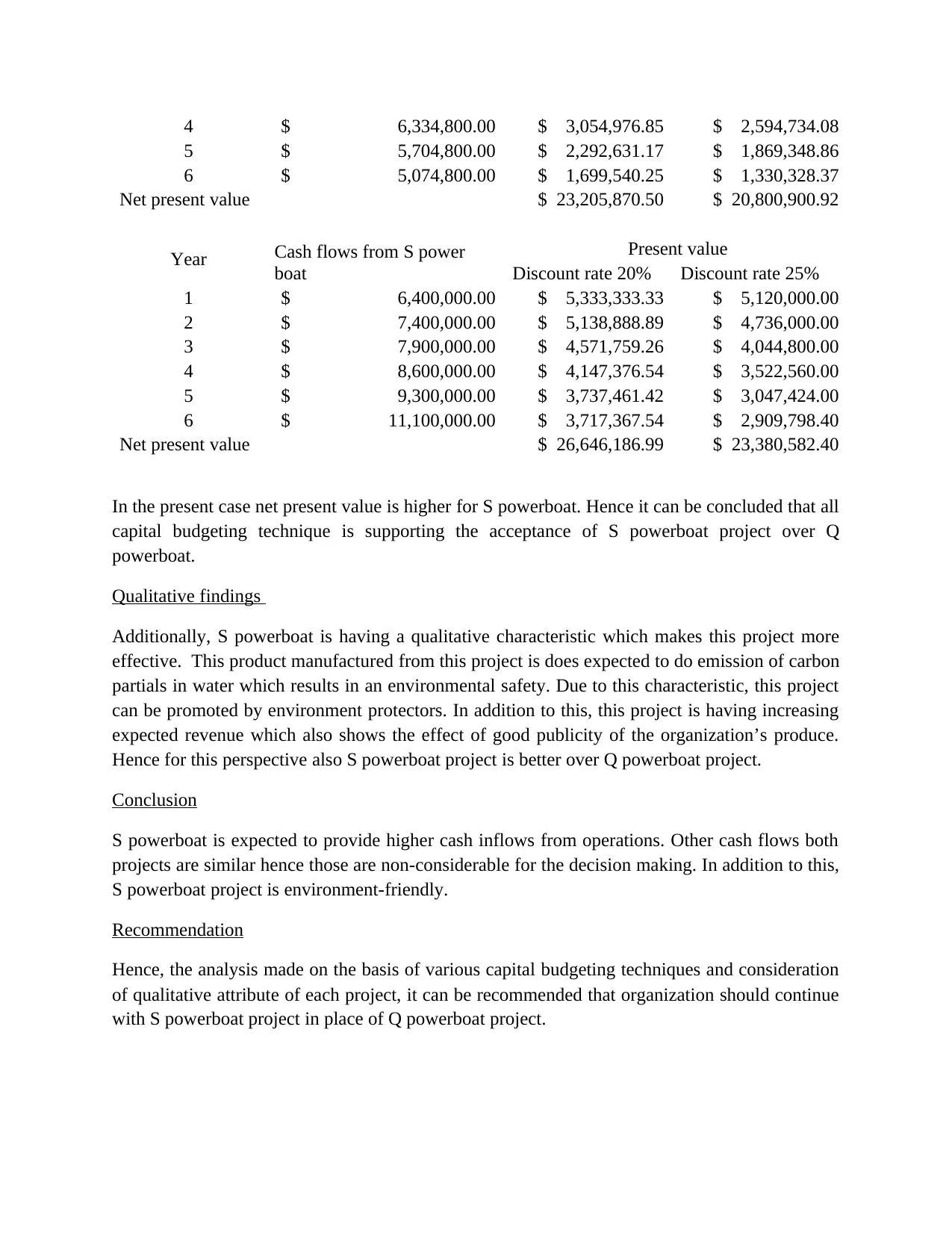
4 $ 6,334,800.00 $ 3,054,976.85 $ 2,594,734.08
5 $ 5,704,800.00 $ 2,292,631.17 $ 1,869,348.86
6 $ 5,074,800.00 $ 1,699,540.25 $ 1,330,328.37
Net present value $ 23,205,870.50 $ 20,800,900.92
Year Cash flows from S power
boat
Present value
Discount rate 20% Discount rate 25%
1 $ 6,400,000.00 $ 5,333,333.33 $ 5,120,000.00
2 $ 7,400,000.00 $ 5,138,888.89 $ 4,736,000.00
3 $ 7,900,000.00 $ 4,571,759.26 $ 4,044,800.00
4 $ 8,600,000.00 $ 4,147,376.54 $ 3,522,560.00
5 $ 9,300,000.00 $ 3,737,461.42 $ 3,047,424.00
6 $ 11,100,000.00 $ 3,717,367.54 $ 2,909,798.40
Net present value $ 26,646,186.99 $ 23,380,582.40
In the present case net present value is higher for S powerboat. Hence it can be concluded that all
capital budgeting technique is supporting the acceptance of S powerboat project over Q
powerboat.
Qualitative findings
Additionally, S powerboat is having a qualitative characteristic which makes this project more
effective. This product manufactured from this project is does expected to do emission of carbon
partials in water which results in an environmental safety. Due to this characteristic, this project
can be promoted by environment protectors. In addition to this, this project is having increasing
expected revenue which also shows the effect of good publicity of the organization’s produce.
Hence for this perspective also S powerboat project is better over Q powerboat project.
Conclusion
S powerboat is expected to provide higher cash inflows from operations. Other cash flows both
projects are similar hence those are non-considerable for the decision making. In addition to this,
S powerboat project is environment-friendly.
Recommendation
Hence, the analysis made on the basis of various capital budgeting techniques and consideration
of qualitative attribute of each project, it can be recommended that organization should continue
with S powerboat project in place of Q powerboat project.
5 $ 5,704,800.00 $ 2,292,631.17 $ 1,869,348.86
6 $ 5,074,800.00 $ 1,699,540.25 $ 1,330,328.37
Net present value $ 23,205,870.50 $ 20,800,900.92
Year Cash flows from S power
boat
Present value
Discount rate 20% Discount rate 25%
1 $ 6,400,000.00 $ 5,333,333.33 $ 5,120,000.00
2 $ 7,400,000.00 $ 5,138,888.89 $ 4,736,000.00
3 $ 7,900,000.00 $ 4,571,759.26 $ 4,044,800.00
4 $ 8,600,000.00 $ 4,147,376.54 $ 3,522,560.00
5 $ 9,300,000.00 $ 3,737,461.42 $ 3,047,424.00
6 $ 11,100,000.00 $ 3,717,367.54 $ 2,909,798.40
Net present value $ 26,646,186.99 $ 23,380,582.40
In the present case net present value is higher for S powerboat. Hence it can be concluded that all
capital budgeting technique is supporting the acceptance of S powerboat project over Q
powerboat.
Qualitative findings
Additionally, S powerboat is having a qualitative characteristic which makes this project more
effective. This product manufactured from this project is does expected to do emission of carbon
partials in water which results in an environmental safety. Due to this characteristic, this project
can be promoted by environment protectors. In addition to this, this project is having increasing
expected revenue which also shows the effect of good publicity of the organization’s produce.
Hence for this perspective also S powerboat project is better over Q powerboat project.
Conclusion
S powerboat is expected to provide higher cash inflows from operations. Other cash flows both
projects are similar hence those are non-considerable for the decision making. In addition to this,
S powerboat project is environment-friendly.
Recommendation
Hence, the analysis made on the basis of various capital budgeting techniques and consideration
of qualitative attribute of each project, it can be recommended that organization should continue
with S powerboat project in place of Q powerboat project.
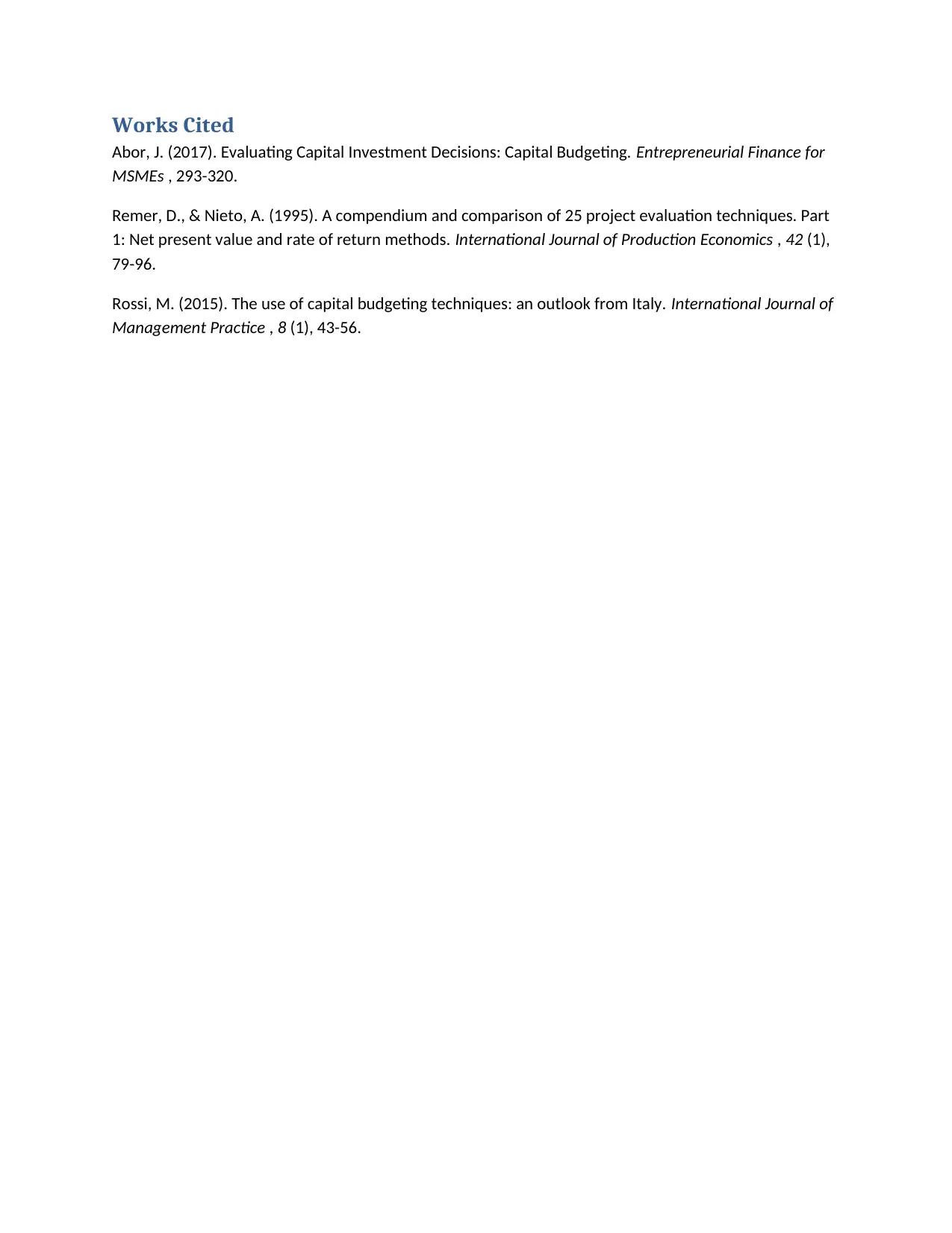
Works Cited
Abor, J. (2017). Evaluating Capital Investment Decisions: Capital Budgeting. Entrepreneurial Finance for
MSMEs , 293-320.
Remer, D., & Nieto, A. (1995). A compendium and comparison of 25 project evaluation techniques. Part
1: Net present value and rate of return methods. International Journal of Production Economics , 42 (1),
79-96.
Rossi, M. (2015). The use of capital budgeting techniques: an outlook from Italy. International Journal of
Management Practice , 8 (1), 43-56.
Abor, J. (2017). Evaluating Capital Investment Decisions: Capital Budgeting. Entrepreneurial Finance for
MSMEs , 293-320.
Remer, D., & Nieto, A. (1995). A compendium and comparison of 25 project evaluation techniques. Part
1: Net present value and rate of return methods. International Journal of Production Economics , 42 (1),
79-96.
Rossi, M. (2015). The use of capital budgeting techniques: an outlook from Italy. International Journal of
Management Practice , 8 (1), 43-56.
⊘ This is a preview!⊘
Do you want full access?
Subscribe today to unlock all pages.

Trusted by 1+ million students worldwide
1 out of 6
Related Documents
Your All-in-One AI-Powered Toolkit for Academic Success.
+13062052269
info@desklib.com
Available 24*7 on WhatsApp / Email
![[object Object]](/_next/static/media/star-bottom.7253800d.svg)
Unlock your academic potential
Copyright © 2020–2025 A2Z Services. All Rights Reserved. Developed and managed by ZUCOL.





